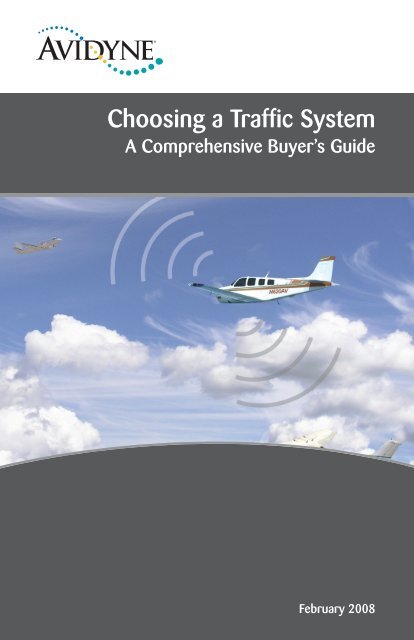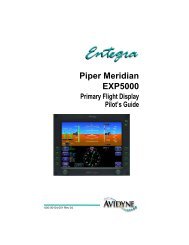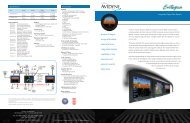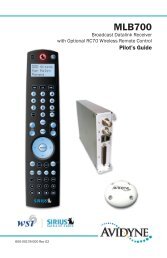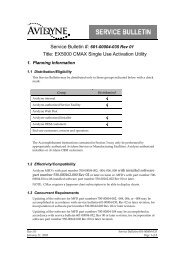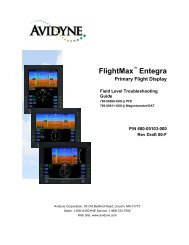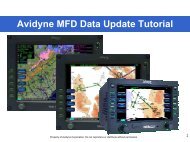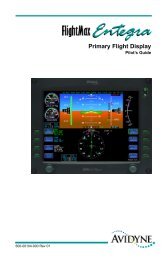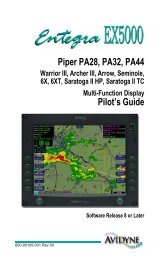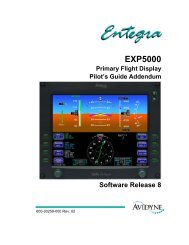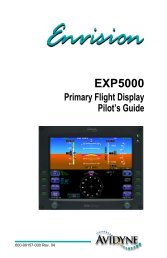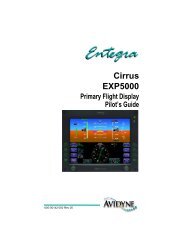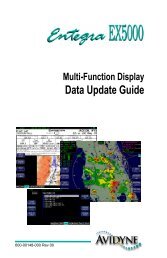Choosing a Traffic System - Avidyne
Choosing a Traffic System - Avidyne
Choosing a Traffic System - Avidyne
- No tags were found...
Create successful ePaper yourself
Turn your PDF publications into a flip-book with our unique Google optimized e-Paper software.
Table of ContentsIntroduction .......................................................................................1<strong>Choosing</strong> a <strong>Traffic</strong> <strong>System</strong> ..................................................................2See and Avoid Concept .........................................................................2<strong>Traffic</strong> <strong>System</strong>s Defined.........................................................................4About the Dual-Antenna TAS600 ..........................................................6Benefits of dual antennas vs single antenna TAS ....................................8Heads-Up Audible Position Alerting.......................................................9Features of <strong>Avidyne</strong> TAS600 Series........................................................9Ground Mode...............................................................................9Approach Mode............................................................................9Weight on Wheels ......................................................................10Audio Mute................................................................................10N-Number Capability..................................................................10Most Display Options..................................................................10Why install a TAS system on my airplane?...........................................11Dare to Compare - Product Comparisons.........................................12<strong>Traffic</strong> <strong>System</strong> Comparison Chart ...................................................12-13-i-<strong>Choosing</strong> a <strong>Traffic</strong> <strong>System</strong>
Intentionally left blank<strong>Choosing</strong> a <strong>Traffic</strong> <strong>System</strong>-ii-
<strong>Choosing</strong> a <strong>Traffic</strong> <strong>System</strong>Deciphering the many different types of traffic systems can be daunting. Therea five different technologies currently available for traffic detection andsurveillance. Below is a summary of the systems technological differences.<strong>Traffic</strong> Collision Avoidance <strong>System</strong> (TCAS)• TCAS I – Active interrogating system issuing real-time traffic alerts (TA) –Primarily found on Turboprop aircraft and smaller jets• TCAS II – Active interrogating system issuing traffic alerts (TA) andresolution advisories (RA)* Federal Aviation Administration (FAA) mandated in Part 121aircraft – applications usually found in large business jets &commercial aircraft<strong>Traffic</strong> Advisory <strong>System</strong> (TAS)(i.e. <strong>Avidyne</strong> TAS600, Honeywell ® KTA870, L-3 Skywatch ® )• Active interrogating system - Not dependent on “third party interrogation”• Meets FAA TSO-C147 specifications• Provides up to a 30-second warning at up to 1200 knot closure(same as TCAS I)• Interrogates threat aircraft transponders for reply• Provides “real-time” collision alertsPassive <strong>Traffic</strong> Detection Devices• Transponder-based technology• Passive reception – relies on 3rd party interrogation• Receiver only, rarely provides bearing information• Reduced effectiveness outside of radar coverage areas<strong>Traffic</strong> Information Services (TIS)• Utilizes Mode-S transponders only (TIS not available outside continental US)• Datalink information received from select Approach Radar facilities only• Not intended specifically for use as collision avoidance• Information susceptible to data loss due to “line-of-sight” reception• Information delayed 5-15 seconds based on radar interrogation “sweep”• Phase out of TIS-capable Ground Stations already underwayAutomatic dependent Service - Broadcast (ADS-B)• Developed as FAA’s Safe Flight 21 project• Supports air-to-air traffic situational awareness, dependent on GPS todetermine position• Implementation still in its infancy and geographically limited• Technology is still not fully defined regarding 1090MHz versus UATtransceiver hardware. NPRM suggests no mandate until 2020.<strong>Choosing</strong> a <strong>Traffic</strong> <strong>System</strong> -4-
<strong>Choosing</strong> a <strong>Traffic</strong> <strong>System</strong>TCAS II provides a similar level of alerts as TAS and TCAS I with the additionof Resolution Advisory or RA. When the TCAS II system detects an imminentintercept course, the intruder aircraft is displayed as a red square and the pilotis audibly instructed to “Climb” or “Descend” and visually directed by theRA/IVSI display with the appropriate vertical speed needed to avert a collision.Both aircraft must be equipped with TCAS II systems to experience an RA.The three most popular TAS systems available for general aviation aircraft arethe <strong>Avidyne</strong>’s TAS600 Series, the L3 Skywatch systems, and Honeywell’sKTA-870 system. These systems detect intruder aircraft based on theperformance guidelines of TSO-C147 for traffic advisory systems. Detection isdetermined by using modeling algorithms to calculate relative altitude,distance, and bearing of the intruder aircraft. TAS systems include a mainProcessor and either a top and bottom antenna configuration (TAS600 andKTA-870) or single top-only antenna set-up (Skywatch). It is worth noting thatall TCAS I and TCAS II systems utilize top and bottom antennas for optimumtraffic coverage and minimal shadowing effects of the fuselage.Dual-Antenna TAS600 <strong>System</strong>Safety is the foremost concern when choosing a traffic system for your aircraft.Other concerns include price, functionality, and installation costs. In the nextfew pages we will clearly show you why <strong>Avidyne</strong>’s TAS600 Series are the mostsafe and economical TAS systems on the market today.<strong>Avidyne</strong>’s TAS600 family of <strong>Traffic</strong> Advisory <strong>System</strong>s (TAS) brings affordableactive-interrogation collision avoidance to a wide variety of general aviationaircraft. All TAS600 systems include <strong>Avidyne</strong>-exclusive features and RyanActive Surveillance (RAS) technology.<strong>Choosing</strong> a <strong>Traffic</strong> <strong>System</strong> -6-
<strong>Choosing</strong> a <strong>Traffic</strong> <strong>System</strong><strong>Avidyne</strong>’s TAS600 Series includes three models, designed for the type of aircraftyou fly:With the TAS600 series, you can choose the right traffic system for your aircraft based onoperating altitude and closure rates (range and speed).TAS600–Recommended for entry-level, single-engine piston aircraft, theTAS600 features a 7nm range, a 3,500-foot vertical separation maximum and18,500-foot service ceiling.TAS610–Recommended for mid-performance aircraft and rotorcraft, theTAS610 features a 12nm range, a 3,500-foot vertical separation maximum anda 25,000-foot service ceiling.TAS620–Recommended for high-performance aircraft and rotorcraft, theTAS620 features a 21nm range, a 9,900-foot vertical separation maximum anda 55,000-foot service ceiling.All TAS600 systems offer these additional features:Patented Top and Bottom AntennasLike the dual-antenna architecture of more expensive TCASsystems used in Airliners and Corporate jets, <strong>Avidyne</strong>’s topand bottom directional antennas interrogate and receivereplies from threat aircraft transponders above and belowthe aircraft. This dual-antenna architecture is designed tominimize surveillance interference from your own airframe.The top antenna provides directional surveillance to the frontand aft on the aircraft. The bottom antenna provides directional surveillance tothe left and right of the aircraft.This dual-antenna architecture provides greateraccuracy for range and bearing resolution of intruder aircraft.-7- <strong>Choosing</strong> a <strong>Traffic</strong> <strong>System</strong>
<strong>Choosing</strong> a <strong>Traffic</strong> <strong>System</strong>Single-antenna systemsThe interrogation signals from single-antenna systems may not always receivereplies due to airframe shadowing, or they can miss replies from aircraftbeneath the host aircraft.Patented Top and Bottom Antennas<strong>Avidyne</strong>’s TAS600 sends out interrogation pulses and listens for replies fromother aircraft 360° around the host aircraft.<strong>Choosing</strong> a <strong>Traffic</strong> <strong>System</strong> -8-
<strong>Choosing</strong> a <strong>Traffic</strong> <strong>System</strong><strong>Avidyne</strong>’s Heads-Up Audible Position Alerting Safety is not limited to visual interpretation, which is why Heads-Up AudiblePosition Alerting is incorporated into all TAS600 Series systems. Heads-UpAudible Position Alerting annunciates the threat alert, clock face position, andrelative vertical position and distance of any threat aircraft within thesurveillance envelope, thus reducing visual overload. With Heads Up AudiblePosition Alerting, the TAS600 clearly alerts the pilot to an imminent threat:TRAFFIC! TWO O’CLOCK! HIGH! THREE MILES!The TAS600 series eliminates the added step of acquiring the intruder aircrafton a display and then visually locating the threat. With the TAS600, you cannow simply, HEAR AND ACQUIRE.Active InterrogationAll TAS600 systems search the sky in real-time in any radar or non-radarenvironment. The interrogation of ATC, military radar, and other activecollision avoidance systems is continuously sent up to 56 times per second bythe TAS600 and can receive replies from Mode A, C, or S transponders.The TAS600, TAS610, and TAS620 are designed to meet the specific needs ofeach class of aircraft, providing a full 30-second decision time at a closure rateof up to 1200 knots. TAS600 series traffic systems interrogate transpondersfrom nearby aircraft within their respective coverage volume, and provide awarning to the flight crew when the calculated time to closest approach (CPA)of any intruder and the protected area around the aircraft reaches the30-second threshold.<strong>Avidyne</strong> TAS600-Series Features & Functions:Ground ModeGround Mode enables the system to ignore traffic on the ground and muteaudio announcement while displaying traffic more than two hundred feet abovethe ground. This feature is important as the aircraft taxis out, especially atuncontrolled airports. The “Weight on Wheels” mode will automatically enableand disable Ground Mode.Approach ModeThe Approach Mode, when engaged, permits the TAS600 Series to ignoretraffic on the ground during the approach phase of a flight. At times the pilotmay desire to “see” traffic during approach, with this in mind, the system wasengineered as a pilot selectable option.-9- <strong>Choosing</strong> a <strong>Traffic</strong> <strong>System</strong>
<strong>Choosing</strong> a <strong>Traffic</strong> <strong>System</strong>Weight on WheelsThis is a discrete input which automatically switches the TAS600 system intoGround Mode upon landing, minimizing any distraction from ground traffic.<strong>Traffic</strong> above the host aircraft is still shown on the multifunction display,without audio warnings. This also allows for continued situational awarenesswhen preparing for departure.Audio Yoke-Mounted Mute and Volume ControlThe TAS600 Series is the only TAS system available with an audio volumecontrol enabling the announcement to be heard by the pilot and crew but notnecessarily heard by passengers. Also available is a yoke-mounted mute buttonwhich allows the system to be muted when needed. If another <strong>Traffic</strong> Alert(TA) is detected, the TAS600 system will automatically disengage the mute andannounce the threat and updated intruder position.N-Number CapabilityMode S transponder-equipped aircraft have the ability to transmit theirN-number, which can be decoded by the TAS600 system. This number can beviewed on compatible multifunction displays when interfaced to the TAS600via its RS232 data bus output.Most Display OptionsThe TAS600 Series provides industry-standard ARINC 429 and RS232 displayoutputs and has the most display options available for TAS systems.With interfaces to the displays of over 15 popular display manufacturers,including <strong>Avidyne</strong>’s Entegra, EX500 and EX5000, the Garmin GNS430/530and G1000, it’s a pretty safe bet that the TAS600 can connect to your displaywith ease.<strong>Choosing</strong> a <strong>Traffic</strong> <strong>System</strong> -10-
<strong>Choosing</strong> a <strong>Traffic</strong> <strong>System</strong>Why should I install a traffic system on my airplane?The most feared of all flying incidents is the mid-air collision. Even when weare vigilant in our “See and Avoid” technique, we fear what we can’t control;the occurrence of “the other guy” who might not be as diligent as us. Perhapsthe fear is out of proportion to the actual threat, but nonetheless it is regardedone of deadliest flying hazards.It’s obvious that mid-airs happen when they are least expected. The pilot’sresponsibility is to visually scan for traffic, and even the best set of eyes canmiss a fast-moving approaching aircraft. This presents a real need for a trafficadvisory system. Throughout the years, statistics have proven that thesesystems have decreased the total number of mid-air collisions.Dare to CompareAircraft owners now have the advantage of installing the most technologicallyadvanced traffic advisory system at a very affordable cost. <strong>Avidyne</strong> has designedthe TAS600 Series with safety as the predominant feature. And starting at only$9,990, the TAS600 is the most affordable active TAS system in the generalaviation marketplace.Competitive traffic systems start at a minimum price of $15,000 with lessfeatures and surveillance capabilities. We encourage you to compare features,functions, technology and value. Consider the TAS600 Series for installationin your aircraft.With <strong>Avidyne</strong>’s MHAS Package Pricing, the savings can be considerable whenthe TAS600 system is bundled with an EX500 or EX5000 MFD and anMLB700 Broadcast Datalink Receiver. Review the full competitive matrix for<strong>Traffic</strong>, MFDs, and Datalink on the following pages to see what we mean.-11- <strong>Choosing</strong> a <strong>Traffic</strong> <strong>System</strong>
<strong>Choosing</strong> a <strong>Traffic</strong> <strong>System</strong>Feature TAS600 TAS610 TAS620Suggested List Price $9,990 $14,990 $20,990ActiveInterrogationYes Yes YesAudible Range,Bearing, Altitude,and Altitude TrendCall-outsYesHeads UpStandardYesHeads UpStandardYesHeads UpStandardTop & BottomAntennasYes Yes YesRange 7nm 12nm 21nmVertical Range ±3,500 ±3,500 ±9,900Service Ceiling 18,500 25,000 55,000Ground Mode Yes Yes YesWeight on Wheels Yes Yes YesYoke Mount Mute Yes Yes YesN-NumberIntruder DisplayNumber ofTargets TrackedNumber ofTargets DisplayedYes Yes Yes50 50 509 9 9<strong>System</strong> Weight 9.29 lbs 9.29 lbs 9.29 lbsProcessorDimensionsW 3.10”H 7.25”D 11.675”W 3.10”H 7.25”D 11.675”W 3.10”H 7.25”D 11.675”<strong>Choosing</strong> a <strong>Traffic</strong> <strong>System</strong> -12-
<strong>Choosing</strong> a <strong>Traffic</strong> <strong>System</strong>FeatureSkywatch497SkywatchHPHoneywellKTA-870Suggested ListPriceActiveInterrogationAudible Range,Bearing, Altitude,and AltitudeTrend Call-outsTop & BottomAntennas$18,890 $25,980 $24,690Yes Yes YesYesOptionalVIPYesOptionalVIPNoNo No YesRange 11nm 35nm 40nmVertical Range ±9,900 ±9,900 ±8,700Service Ceiling 55,000 55,000 55,000Ground Mode Yes Yes YesWeight onWheelsYes Yes YesYoke Mount Mute No No NoN-NumberIntruder DisplayNumber ofTargets TrackedNumber ofTargets DisplayedNo No No30 35 6010 10 60<strong>System</strong> Weight 8.94 lbs 9 lbs 15.20 lbsProcessorDimensionsW 12.52”H 3.56”D 7.62”W 12.52”H 3.56”D 7.62”W 4.5”H 7.0”D 13.8”Comparison data based on mfg. website data and is subject to change without notice.-13- <strong>Choosing</strong> a <strong>Traffic</strong> <strong>System</strong>
<strong>Choosing</strong> a <strong>Traffic</strong> <strong>System</strong> -14-
International customers please contact:DAC International, Inc.6702 McNeil Dr.Austin, TX 78729Telephone: 512-331-5323Email: <strong>Avidyne</strong>@dacint.comwww.dacint.com®55 Old Bedford RoadLincoln, MA 01773Telephone: 781-402-7400 Toll Free: 800-AVIDYNE (800-284-3963)FAX:781-402-7599www.avidyne.comAV679 Rev 01 2/08 5000©2008 <strong>Avidyne</strong> Corporation All Rights Reserved.Other company and product names may be trademarksof the respective companies with which they are associated.


